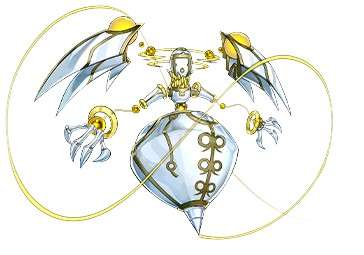More on the Sacred Beast Structure Deck
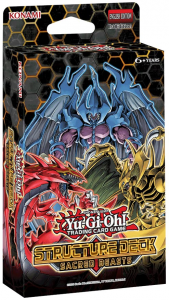
Welcome back to an Introduction to the 'Sacred Beast' cards! In Part 1, we went over the existing cards in the deck and the initial support they had. Then we began to talk about what the new Structure Deck offered. We spoke about "Dark Beckoning Beast" and "Opening of the Spirit Gates", which are the main starter cards. Then "Chaos Summoning Beast" to make the deck more consistent than ever before. It's recommended you read that first if you haven't already, then move onto this one as those cards are important to know about going forward. Now it's time to talk about the remaining Structure Deck support for this strategy.
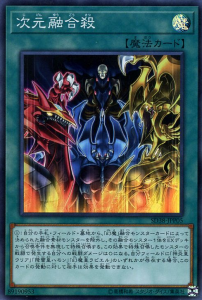
Dimension Fusion Destruction
This is “Dimension Fusion Destruction”, a card originally seen in the anime. In the anime, Armityle required this to be summoned, but in the real game, you just had to have the materials on the field. However, having all three ‘Sacred Beasts’ on the field was a huge task, as it took a lot of resources. Therefore, the real version of this card, added to the Structure Deck, gives us a new means of bringing it out. This card fixes many of the issues with summoning Armityle more reasonably.
You can use this card to summon either Armityle or Trilojig to the field. The materials can be sent from not just the field, but also your hand or Graveyard. This means you don’t actually need to summon the material to get out your boss monster any more, finally making it a viable strategy. If you control at least one of the ‘Sacred Beasts’ on the field still, when you play this, you still get a bonus. That being, the opponent can’t respond to this card’s activation. If this isn’t the case, you will be potentially prone to disruption, so be careful when activating it.
The other problem that Armityle had before was that even though it wasn’t destroyed, you would still take the damage. If you summon Armityle via this card, you won’t take damage from attacks involving it. Now, even if you can’t push forth with the OTK and Armityle goes to 0 Attack on your opponent’s turn, the opponent can’t simply run over it and defeat you right away. For an Armityle focused build, you probably want to run three of these, as well as “Predaplant Verte Anaconda” to make it even more live. We’ll talk more about how that goes momentarily.
Now that Armityle is a monster that could realistically be summoned, the next step is actually having the ‘Sacred Beasts’ available as material. The easiest method would be to put them in the Graveyard. Sure, you could gradually use things like “Foolish Burial” or “Fiendish Rhino Warrior” to slowly put them there. Or you could use the next card on this list.
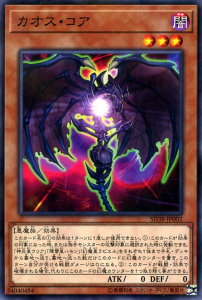
Chaos Core
Another card from the GX anime brought into the real game via the Structure Deck. Chaos Core is designed to get the ‘Sacred Beasts’ into the Graveyard so you can play “Dimension Fusion Destruction”. This card is usually a 1 of, since you usually want to search it instead of hard draw it, but you could run two of them if you have the room. If your opponent has a bunch of ways to deal with it, maybe have your second copy in the side deck.
When an effect is activated that targets “Chaos Core”, you get to instantly send all three of the ‘Sacred Beasts’ from your deck into the Graveyard. This also puts ‘Phantasm Counters’ on Chaos Core, which gives it some protection. Though that part isn’t as important, since you are likely going to Link away “Chaos Core” afterwards anyway. You might be thinking that having to wait for being targeted is a pretty slow thing and that’s usually true… but there is a card that can help speed that up.
The Armityle Combo!
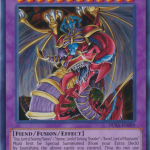
Phantom
We’ve got our main combo pieces ready. While there’s some additional ‘Sacred Beast’ cards to talk about afterwards, we are ready to talk about the main combo. The aim is to activate “Chaos Core” and then “Dimension Fusion Destruction”. After that, you have Armityle on the field and ready to OTK with big damage!
Step 1 requires you to have one of your starter cards in hand. That’s either “Dark Beckoning Beast” or “Opening of the Spirit Gates”. You need one of those plus one of any other card, as you need a discard fodder card later; “Chaos Summoning Beast” would be an ideal example as it can then get out “Fallen Paradise” for you. Once you’ve got one of your starters, you are ready to begin.
If you start with “Opening of the Spirit Gates”, activate it and search “Dark Beckoning Beast”. Normal Summon it and then search “Chaos Core”. If you start with “Dark Beckoning Beast”, Normal Summon it and search “Opening of the Spirit Gates”. Activate that and then search “Chaos Core”. That’s Step 1 complete.
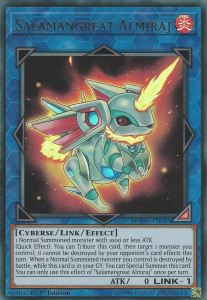
You’ve got your extra Normal Summon with “Dark Beckoning Beast”, so Normal Summon the “Chaos Core” you just searched. Now you want to Link Summon away “Dark Beckoning Beast” into “Salamangreat Almiraj”.
Activate the effect of Almiraj to target “Chaos Core” with its effect of protecting it from destruction effects. Almiraj will tribute itself and “Chaos Core” will have been targeted. This triggers the effect of “Chaos Core”, allowing you to send all three of the ‘Sacred Beasts’ to the Graveyard. That’s Step 2 done.
Now for Step 3, you want to activate the other effect of “Opening of the Spirit Gates” and discard a card in your hand, in order to revive “Dark Beckoning Beast” from the Graveyard, it having been sent there before. It won’t be there for long as now you are going to use both it and your “Chaos Core” for a Link 2 Summon. While it’s not as budget friendly as the rest of this deck, you then bring out “Predaplant Verte Anaconda”
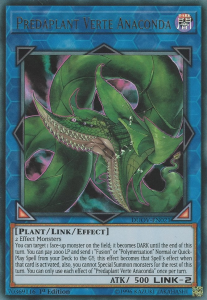
You use Verte’s effect to pay 2000 Life Points and send “Dimension Fusion Destruction” from your deck to the Graveyard; Verte gains its effect and you can use the ‘Sacred Beasts’ in your Graveyard as material to bring out “Armityle, the Chaos Phantasm”. Or Trilojig if you want, but usually Armityle. That’s Step 4 and your combo is complete! Alternatively, if you had “Dimension Fusion Destruction” in your hand already, you could just play that and skip Verte. However, if you don’t, Verte means this combo is only a two card combo: one of your starters and a card to discard.
To summarise:
Opening Hand: Either “Dark Beckoning Beast” or “Opening of the Spirit Gates” plus one ready to discard
Step 1- Normal Summon “Dark Beckoning Beast” and search “Opening of the Spirit Gates”. Activate that and search “Chaos Core”.
Alternative Step 1- Activate “Opening of the Spirit Gates” and search “Dark Beckoning Beast”, then Normal Summon it. Use that to search “Chaos Core”.
Step 2- Link away “Dark Beckoning Beast” into “Salamangreat Almiraj. Use its effect to target “Chaos Core”, sending the three ‘Sacred Beasts’ from your deck to your Graveyard.
Step 3- Use the “Opening of the Spirit Gates” effect to discard a card to revive “Dark Beckoning Beast”. Use it and “Chaos Core” to Link Summon “Predaplant Verte Anaconda”.
Step 4- Use Verte’s effect to send “Dimension Fusion Destruction” from your deck to the Graveyard. Summon “Armityle the Chaos Phantasm”, or alternatively “Phantasm Emperor Trilojig”.
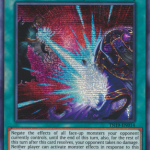
With that, you’ve got out Armityle onto the field and are ready to perform a big OTK of ten-thousand damage. While, this strategy may get disrupted along the line, you can try to put a stop that. Something like “Dark Ruler No More” may help you out there, perhaps.
We’ve got a few remaining new support cards left to talk about. So it’s time to introduce those.
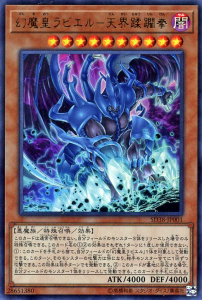
Raviel, Lord of Phantasms - Shimmering Scraper
This guy gives you an alternative OTK option, using “Raviel, Lord of Phantasms”. You could summon this as a 4000 Attack and Defence body on the field; being Tribute any three monsters, not just Fiend types. While you could do that, its main purpose is to be in your hand. When you have the original Raviel on the field, you discard Scraper and double Raviel’s attack to 8000. Not only that, Raviel will now be able to attack all monsters your opponent controls. This should hopefully add up to a nice board clear and a lot of damage.
In a general ‘Sacred Beast’ deck, this is a decent 1 of card as an alternative win condition. But in a build more focused on Raviel, you should run more of them.
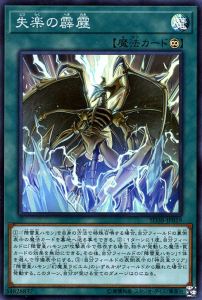
Cerulean Sky Fire
“Cerulean Sky Fire” provides a good Continuous Spell option for the deck. What makes this even better is that when active, it has the effect to make any Spell you control that is face-down be something you can tribute for Hamon, not just Continuous Spells. This makes running any kind of Spell card better. Perhaps you had “Fallen Paradise” already live; so now the stray “Terraforming” you didn’t have a use for has another purpose. Maybe you opened more than one “Dimension Fusion Destruction”.
In addition to helping get out Hamon, this card is also an extra layer of protection. If you control Hamon in Attack position and your opponent activates a Spell or Trap card or effect, you can negate that effect by switching Hamon into Defense. Moving your big guy into Defense is not too big a cost. Not only does it still have a lot of Defense points, but its effect to protect other monsters goes live. Later on, you can put Hamon back into Attack position and do it all over again.
This card also possesses a third effect. When any ‘Sacred Beast’ leave the field, you won’t take any damage for the rest of that turn. Therefore, if your opponent is able to break your board, you at least won’t then get OTK’d. Then hopefully you’ll mount your comeback when your turn rolls back around. While the second and third effects of these cards are pretty good, you often will use “Cerulean Sky Fire” as tribute for Hamon more than anything else, so you’d need additional copies ready afterwards to use the effects more. For that, you usually want to run three, but if you have space issues, then running two is fine.
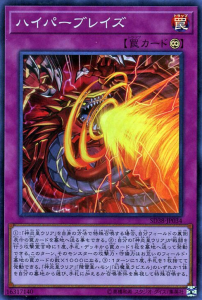
Hyper Blaze
“Hyper Blaze” is at first a Trap version for Uria to what “Cerulean Sky Fire” is for Hamon. “Cerulean Sky Fire” allowed you to use any Face-Down Spell as something to tribute for Hamon. In turn, “Hyper Blaze” lets you use any Face-Down Trap card for summoning Uria. As Uria usually required Face-Up Traps, this usually meant Continuous ones. This means Normal and Counter Traps are more available. However, there aren’t that many Trap cards that get used in this deck. There’s a chance that if you don’t have Hyper Blaze active, your regular Traps won’t be as helpful; especially when you’d rather open your combo pieces. However, this is a nice other use for an unusable “Metaverse” if you’ve already got your “Fallen Paradise” out. It does help to have more Trap options open.
Of course, “Hyper Blaze” does a little more than just that. When an attack involving Uria is declared, you can send a Trap card from your deck to the Graveyard. Then Uria’s attack becomes equal to the number of Traps both Face-Up and in the Graveyard times 1000. This gives Uria a bit more attack than he would usually have through just the Graveyard alone. Since “Hyper Blaze” would be in the field in this instance, that’s at least 1000 more ATK. This fits in with the attack manipulation that some of the other ‘Sacred Beast’ related cards have. But isn’t as good as some of those.
The third effect may be the best one. Once per turn, you can discard a card to resurrect any of the three ‘Sacred Beasts’; Uria, Hamon or Raviel from the Graveyard. That’s something you usually can’t do based on their summoning conditions, but this card bypasses that. It provides a very nice bit of resurrection for the deck. While it being a Trap card makes it slow, it’s probably the best option we have for that. Therefore, you’d want to run two to three of them and is probably your main method of making Uria. For a ‘Sacred Beast’ deck, at least two.
Uria is a card that works in its own focussed deck outside of the general overall ‘Sacred Beasts’ with Armityle and such. Usually, you’d want to fill up on Trap Monsters or other Continuous Traps that act as floodgates or something, while building up Uria’s attacks to high levels. This card provides a nice upgrade for that specific build. In those, you’d definitely want to run three.
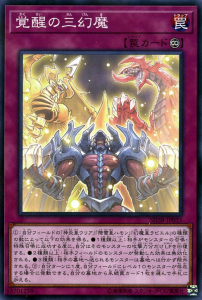
Awakening of the Sacred Beasts
Lastly, from the new Structure Deck support, you have this. It’s your alternative win condition card and when live, it’s very impactful. Due to being a Trap card, it’s fairly slow and it also takes time to get its effect really going, but it’s a good option to run in the deck, at usually two copies, as three is going to clog. It’s not something you necessarily want to open, especially going second.
So what does it do? It has three primary effects, each corresponding to how many of the ‘Sacred Beasts’ you control. That means one copy of each of Hamon, Raviel and Uria; duplicates don’t count. If you have none, this card doesn’t do all that much, it’s mostly Uria fodder. However, it has a fourth effect that works if you control any Level 10 monster, where once per turn, you can add a Continuous Trap from your Graveyard to your hand. This helps with the Uria summoning or maybe bringing back a “Metal Reflect Slime” or “Fiendish Chain”.
If you got one of the ‘Sacred Beasts’ or more, then you gain Life Points equal to the ATK of a monster your opponent summons. That’s not the most powerful ability by itself, but it’s pretty nice to get Life Points, especially if you had to pay 2000 to play “Predaplant Verte Anaconda”.
But to really get use of this card, you need at least two of them out. With two or more, you can negate the activated effects of monsters your opponent controls. Some effect negation makes for a pretty nice floodgate, allowing you to perform your plays with less chance of being disrupted. Keep in mind that this is only for ones your opponent controls, so anything off of the field is going to still go through.
If you have all three ‘Sacred Beasts’ on the field, then it has another effect. This is less likely to happen as gathering all three is still a very difficult endeavor, despite all the new support making bringing them out slightly easier. Because of that, you are probably aiming to get the two or more effect, rather than this one. If you manage all three though, then any monster sent to your opponent’s Graveyard is banished instead. That can work out pretty fantastic; taking away the Graveyard as a resource from them. Unless they have a banishing focused deck like ‘Gren Maju’, then you’ve managed to get up a card similar to “Macro Cosmos” and potentially messed up a lot of their plans.
A Few Other Options to Consider
That’s the support from the Structure Deck, bringing the deck from a series of near-unplayable boss monsters that had a very good Field Spell at least, to something playable and fun to pull off. While this is primarily an introduction to these cards, rather than a deep dive analysis, I thought it’d be okay to at least briefly go over a few other things that are worth considering using.
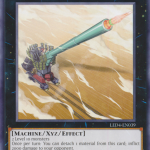
Cannon Gustav Max
Firstly, this deck is mostly Level 10 based. Along with the ‘Sacred Beasts’, there has been mention of “Metal Reflect Slime” and “Egyptian God Slime” that are also Level 10s. If you have room, something such as “Tragoedia” too. With these Level 10s, you have access to Rank 10s potentially. That starts to give your Extra Deck a bunch of things to put in. You have the Rank 10 Train cards, such as “Superdreadnought Rail Cannon Gustav Max”, that allows you detach a material to inflict big damage. If you can’t pull off the OTK with Raviel perhaps, then this may give you the push you need to finish things.
For Rank 10s, you also have the spider ‘Number’ package. “Number 35: Ravenous Tarantula” is a Rank 10 that can Rank Up itself into a Rank 11 and 12, culminating in “Number 77: The Seven Sins” that allows you to banish a whole bunch of monsters from your opponent’s field. Since this deck has a bunch of Dark Attribute monsters, you are also good with “Super Polymerization”, getting out “Starving Venom Fusion Dragon”. “Muddragon of the Swamp” is also a nice option for that.
Alternatively, if you don’t care too much about most of the Extra Deck, play “Pot of Extravagance." But make sure you have three Armityle instead of the usual 1-2 in order to compensate.
If you want to protect your monsters from being destroyed before you can do what you need to do, then “Starlight Road” and “The Huge Revolution is Over” are both nice Traps you can play here, usually in the Side Deck. For other protection from disruption, “Fiendish Chain” has been previously mentioned. You also have “Dark Ruler No More” and “Called by the Grave” in helping you get your combo off uninterrupted.
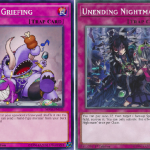
Unending Nightmare
Fiend Griefing can shuffle a card from your opponent’s Graveyard into the deck is good at clearing their Graveyard; the cost being you send a Fiend from your own deck to the Graveyard. That cost isn’t so bad though, as it means sending something like “Chaos Summoning Beast” for that Field Spell search.
“Unending Nightmare” is a decent Continuous Trap that provides a tribute for Uria. It allows you pay 1000 Life Points to out your opponent’s Spell and Traps. However, like a certain Typhoon, this card won’t negate them, so play it carefully.
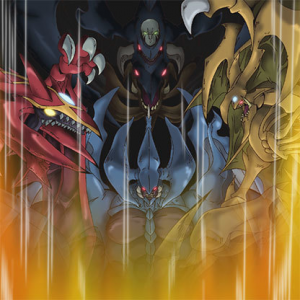
Conclusion
Like most big anime boss monsters, Sacred Beasts did not translate into a practical real world strategy. Despite getting “Fallen Paradise”, a card that gave them a lot of card advantage, the deck was not playable. Getting Armityle on the field was a pipe dream. But now the Structure Deck poll gives a new chance for the deck. The ‘Sacred Beasts’ could come together into a real deck. Before it wasn’t really much of a deck, especially one with all the ‘Sacred Beasts,' but now it certainly is.
They got two wonderful starter cards, a method to get out Armityle via a simple combo and other means to make the ‘Sacred Beasts’ easier summons. The support also remedied some of their other problems. This kind of support was what the more Normal Summon reliant “Egyptian Gods” and “Wicked Gods” could only dream of. This is still a simple OTK based deck. More competitive decks can easily disrupt it. The deck is now at the very least playable. It has a bunch of fun toys to play with. It's okay for a casual deck to take to a ‘locals’ or play with friends. It’s not going to be a Meta Deck any time soon, but it’s something.
I hope this introduction inspires you to check out these cards and start giving them a whirl. Experimentation and discovery will be important here. There could be some interesting hybrid decks with other strategies. Then you can feel awesome when you deal ten thousand points of damage with one blow!
